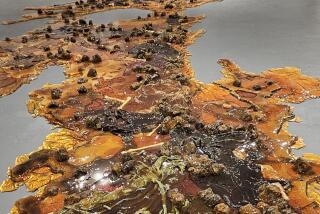Review: Alison Saar turns things ‘Topsy Turvy’ at L.A. Louver
- Share via
When we first meet Topsy in the pages of “Uncle Tom’s Cabin,” the enslaved young girl grins, “goblin-like,” and repeatedly professes her wickedness. She embodies blackness to her young mistress Eva’s whiteness; she plays devil to Eva’s saint, base earth to Eva’s ethereal spirit. She comes into the St. Clare family as a civilizing project, a heathen to be educated, tamed, Christianized.
When we encounter the sculpted Topsy in Alison Saar’s vital show at L.A. Louver, she bristles with self-possession. The “sundry little tails” of her “woolly hair,” emblems in the novel of her wild, chaotic nature, have been rendered as wire twists radiating from her head like a spiky halo of energy.
In one arresting piece, the chiseled and tarred wood figure stands with a sickle in one hand and a gold-leafed shock of hair in the other. Saar makes Topsy at once into the mythic Jason returning with the Golden Fleece, a warrior announcing her conquest via bloody scalp, and a distorted echo of the little girl in Harriet Beecher Stowe’s novel, treasuring the golden lock granted her by Eva upon her deathbed.
Hair has long served as a charged carrier of identity in Saar’s work. It’s been central as form, subject and metaphor in the work of Lorna Simpson, Sonya Clark and others. For Saar, hair is one of several parts of the body — especially the black, female body — where the personal, political and poetic converge. Skin — often sheathed in hammered tin — is another. And eyes, another. The eyes of nearly all of Saar’s sculptures are open, but their focus seems turned inward, as if the figures are protecting a deep, inner power by not giving up their gaze.
The physical expression and symbolic reclamation of power pulses through the work in “Topsy Turvy.” As the title suggests, Saar is turning things upside down and inside out, giving rage and right their day. Nowhere is this more exhilarating than in the sculptures of five little girls, armed with the vintage tools of their field labor — tobacco knife, hoe, bale hook — and a formidable intensity of purpose.
They are a miniature battalion, camouflaged for stealthy advance by cotton bolls poking up from their braids. They are the very image of self-determination, as is the Topsy-derived character in “Jubilee,” a compact nude, in a stunning standing twist, cutting off her own braids with a sickle.
“Do you know who made you?” Topsy is asked, shortly after being introduced in the novel. She doesn’t give the desired answer, God, but her behavior gives a more honest one: Cruelty and injustice made her who she is. Saar has brilliantly made and remade Topsy, restoring her innate power to make herself.
L.A. Louver, 45 N. Venice Blvd., Venice. Trough May 12; closed Sundays and Mondays. (310) 822-4955, www.lalouver.com
See all of our latest arts news and reviews at latimes.com/arts.
MORE ART:
‘My Kid Could Do That’: The childhood art of Ruscha, Opie, Aitken and others
Fired MOCA curator will give UCLA commencement address
What does it mean to be of mixed race in America? An exhibition aim to answer
More to Read
The biggest entertainment stories
Get our big stories about Hollywood, film, television, music, arts, culture and more right in your inbox as soon as they publish.
You may occasionally receive promotional content from the Los Angeles Times.










